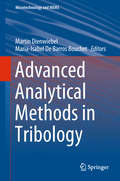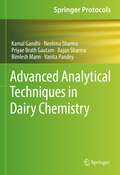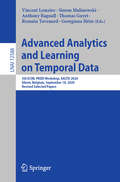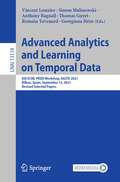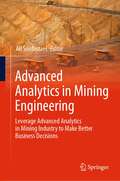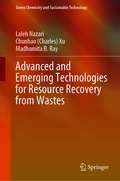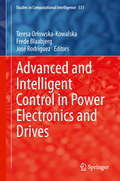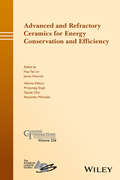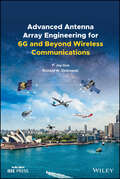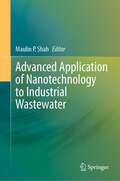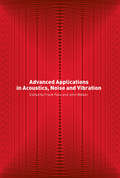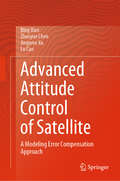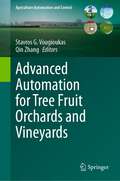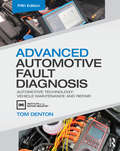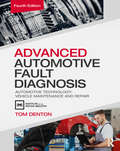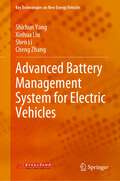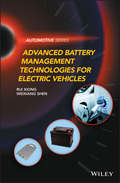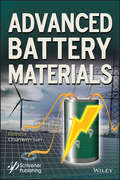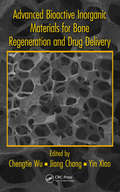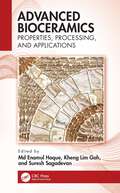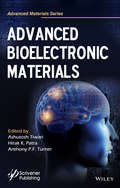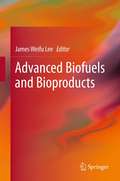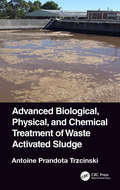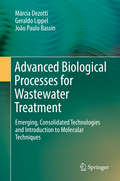- Table View
- List View
Advanced Analytical Methods in Tribology (Microtechnology and MEMS)
by Martin Dienwiebel Maria-Isabel De Barros BouchetThis book presents the basics and methods of nanoscale analytical techniques for tribology field. It gives guidance to the application of mechanical, microstructural, chemical characterization methods and topography analysis of materials. It provides an overview of the of state-of-the-art for researchers and practitioners in the field of tribology. It shows different examples to the application of mechanical, microstructural, chemical characterization methods and topography analysis of materials. Friction and Wear phenomena are governed by complexe processes at the interface of sliding surfaces. For a detailed understanding of these phenomena many surface sensitive techniques have become available in recent years. The applied methods are atom probe tomography, in situ TEM, SERS, NEXAFS, in situ XPS, nanoindentation and in situ Raman spectroscopy. A survey of new related numerical calculations completes this book. This concerns ab-initio coupling, numerical calculations for mechanical aspects and density functional theory (DFT) to study chemical reactivity.
Advanced Analytical Techniques in Dairy Chemistry (Springer Protocols Handbooks)
by Rajan Sharma Kamal Gandhi Priyae Brath Gautam Bimlesh Mann Neelima Sharma Vanita PandeyThis book compiles the advanced analytical techniques used in Dairy Chemistry research. It begins with the basic laboratory techniques and progresses towards techniques like spectroscopy, membrane processes, Western blotting etc. It provides step-by-step protocols for easy reproduction. It also provides troubleshooting guides. This one-of-a-kind protocols book is specifically designed for techniques used in Dairy Science research. It discusses all the necessary steps in different techniques, starting from sample preparations, standardizations and safety measures. It discusses the different techniques in assessing the quality of milk and milk products especially concerning to adulteration. It also includes the techniques used in assessing the active components in functional foods. The book is meant for students and researchers working in the field of Dairy and Food science. It is also useful for experts in the Dairy Industry.
Advanced Analytics and Learning on Temporal Data: 5th ECML PKDD Workshop, AALTD 2020, Ghent, Belgium, September 18, 2020, Revised Selected Papers (Lecture Notes in Computer Science #12588)
by Vincent Lemaire Simon Malinowski Anthony Bagnall Thomas Guyet Romain Tavenard Georgiana IfrimThis book constitutes the refereed proceedings of the 4th ECML PKDD Workshop on Advanced Analytics and Learning on Temporal Data, AALTD 2019, held in Ghent, Belgium, in September 2020. The 15 full papers presented in this book were carefully reviewed and selected from 29 submissions. The selected papers are devoted to topics such as Temporal Data Clustering; Classification of Univariate and Multivariate Time Series; Early Classification of Temporal Data; Deep Learning and Learning Representations for Temporal Data; Modeling Temporal Dependencies; Advanced Forecasting and Prediction Models; Space-Temporal Statistical Analysis; Functional Data Analysis Methods; Temporal Data Streams; Interpretable Time-Series Analysis Methods; Dimensionality Reduction, Sparsity, Algorithmic Complexity and Big Data Challenge; and Bio-Informatics, Medical, Energy Consumption, Temporal Data.
Advanced Analytics and Learning on Temporal Data: 6th ECML PKDD Workshop, AALTD 2021, Bilbao, Spain, September 13, 2021, Revised Selected Papers (Lecture Notes in Computer Science #13114)
by Vincent Lemaire Simon Malinowski Anthony Bagnall Thomas Guyet Romain Tavenard Georgiana IfrimThis book constitutes the refereed proceedings of the 6th ECML PKDD Workshop on Advanced Analytics and Learning on Temporal Data, AALTD 2021, held during September 13-17, 2021. The workshop was planned to take place in Bilbao, Spain, but was held virtually due to the COVID-19 pandemic. The 12 full papers presented in this book were carefully reviewed and selected from 21 submissions. They focus on the following topics: Temporal Data Clustering; Classification of Univariate and Multivariate Time Series; Multivariate Time Series Co-clustering; Efficient Event Detection; Modeling Temporal Dependencies; Advanced Forecasting and Prediction Models; Cluster-based Forecasting; Explanation Methods for Time Series Classification; Multimodal Meta-Learning for Time Series Regression; and Multivariate Time Series Anomaly Detection.
Advanced Analytics in Mining Engineering: Leverage Advanced Analytics in Mining Industry to Make Better Business Decisions
by Ali SoofastaeiIn this book, Dr. Soofastaei and his colleagues reveal how all mining managers can effectively deploy advanced analytics in their day-to-day operations- one business decision at a time.Most mining companies have a massive amount of data at their disposal. However, they cannot use the stored data in any meaningful way. The powerful new business tool-advanced analytics enables many mining companies to aggressively leverage their data in key business decisions and processes with impressive results.From statistical analysis to machine learning and artificial intelligence, the authors show how many analytical tools can improve decisions about everything in the mine value chain, from exploration to marketing.Combining the science of advanced analytics with the mining industrial business solutions, introduce the “Advanced Analytics in Mining Engineering Book” as a practical road map and tools for unleashing the potential buried in your company’s data.The book is aimed at providing mining executives, managers, and research and development teams with an understanding of the business value and applicability of different analytic approaches and helping data analytics leads by giving them a business framework in which to assess the value, cost, and risk of potential analytical solutions. In addition, the book will provide the next generation of miners – undergraduate and graduate IT and mining engineering students – with an understanding of data analytics applied to the mining industry. By providing a book with chapters structured in line with the mining value chain, we will provide a clear, enterprise-level view of where and how advanced data analytics can best be applied. This book highlights the potential to interconnect activities in the mining enterprise better. Furthermore, the book explores the opportunities for optimization and increased productivity offered by better interoperability along the mining value chain – in line with the emerging vision of creating a digital mine with much-enhanced capabilities for modeling, simulation, and the use of digital twins – in line with leading “digital” industries.
Advanced and Emerging Technologies for Resource Recovery from Wastes (Green Chemistry and Sustainable Technology)
by Laleh Nazari Chunbao (Charles) Xu Madhumita B. RayThis book introduces advanced or emerging technologies for conversion of wastes into a variety of high-value chemicals and materials. Energy and resources can be recovered from various residential, industrial and commercial wastes, such as municipal wastewater and sludge, e-waste, waste plastics and resins, crop residues, forestry residues and lignin. Advanced waste-to-resource and energy technologies like pyrolysis, hydrothermal liquefaction, fractionation, de-polymerization, gasification and carbonization are also introduced. The book serves as an essential guide to dealing with various types of wastes and the methods of disposal, recovery, recycling and re-use. As such it is a valuable resource for a wide readership, including graduate students, academic researchers, industrial researchers and practitioners in chemical engineering, waste management, waste to energy and resources conversion and biorefinery.
Advanced and Intelligent Control in Power Electronics and Drives (Studies in Computational Intelligence #531)
by José Rodríguez Frede Blaabjerg Teresa Orłowska-KowalskaPower electronics and variable frequency drives are continuously developing multidisciplinary fields in electrical engineering and it is practically not possible to write a book covering the entire area by one individual specialist. Especially by taking account the recent fast development in the neighboring fields like control theory, computational intelligence and signal processing, which all strongly influence new solutions in control of power electronics and drives. Therefore, this book is written by individual key specialist working on the area of modern advanced control methods which penetrates current implementation of power converters and drives. Although some of the presented methods are still not adopted by industry, they create new solutions with high further research and application potential. The material of the book is presented in the following three parts: Part I: Advanced Power Electronic Control in Renewable Energy Sources (Chapters 1-4), Part II: Predictive Control of Power Converters and Drives (5-7), Part III: Neurocontrol and Nonlinear Control of Power Converters and Drives (8-11). The book is intended for engineers, researchers and students in the field of power electronics and drives who are interested in the use of advanced control methods and also for specialists from the control theory area who like to explore new area of applications.
Advanced and Refractory Ceramics for Energy Conservation and Efficiency: Ceramic Transactions, Volume 256
by Tatsuki Ohji Alexander Michaelis Hua-Tay Lin Mrityunjay Singh James HemrickThis volume contains a collection of 19 papers from the 11th International Symposium on Ceramic Materials and Components for Energy and Environmental Applications (CMCEE-11), June 14-19, 2015 in Vancouver, BC, Canada. Papers were presented in the below five symposia from Track 2 on the topic of Ceramics for Energy Conservation and Efficiency: Advanced Ceramics and Composites for Gas Turbine Engines Advanced Refractory Ceramic Materials and Technologies Advanced Ceramic Coatings for Power Systems Energy Efficient Advanced Bearings and Wear Resistant Materials Advanced Nitrides and Related Materials for Energy Applications
Advanced Antenna Array Engineering for 6G and Beyond Wireless Communications
by Yingjie Jay Guo Richard W. ZiolkowskiAdvanced Antenna Array Engineering for 6G and Beyond Wireless Communications Reviews advances in the design and deployment of antenna arrays for future generations of wireless communication systems, offering new solutions for the telecommunications industry Advanced Antenna Array Engineering for 6G and Beyond Wireless Communications addresses the challenges in designing and deploying antennas and antenna arrays which deliver 6G and beyond performance with high energy efficiency and possess the capability of being immune to interference caused by different systems mounted on the same platforms. This timely and authoritative volume presents innovative solutions for developing integrated communications networks of high-gain, individually-scannable, multi-beam antennas that are reconfigurable and conformable to all platforms, thus enabling the evolving integrated land, air and space communications networks. The text begins with an up-to-date discussion of the engineering issues facing future wireless communications systems, followed by a detailed discussion of different beamforming networks for multi-beam antennas. Subsequent chapters address problems of 4G/5G antenna collocation, discuss differentially-fed antenna arrays, explore conformal transmit arrays for airborne platforms, and present latest results on fixed frequency beam scanning leaky wave antennas as well as various analogue beam synthesizing strategies. Based primarily on the authors’ extensive work in the field, including original research never before published, this important new volume: Reviews multi-beam feed networks, array decoupling and de-scattering methods Provides a systematic study on differentially fed antenna arrays that are resistant to interference caused by future multifunctional/multi-generation systems Features previously unpublished material on conformal transmit arrays based on Huygen’s metasufaces and reconfigurable leaky wave antennas Includes novel algorithms for synthesizing and optimizing thinned massive arrays, conformal arrays, frequency invariant arrays, and other future arrays Advanced Antenna Array Engineering for 6G and Beyond Wireless Communications is an invaluable resource for antenna engineers and researchers, as well as graduate and senior undergraduate students in the field.
Advanced Application of Nanotechnology to Industrial Wastewater
by Maulin P. ShahThis book discusses new and innovative trends and techniques in the application of nanotechnology to industrial wastewater treatment both at a laboratory scale and an industry scale, including treatment, remediation, sensing and pollution prevention. The book also explores unique physicochemical and surface properties of nanoparticles; it highlights advantages they provide for engineering applications. Each chapter covers a different nanotechnology-based approach and examines basic principles, practical applications, recent breakthroughs and associated limitations. Nanotechnology applications to wastewater research have significant impact in maintaining the long-term quality, availability and viability of water. Regardless of the origin—for example, municipal or industrial wastewater—the remediation nanotechnology allows water to be recycled and desalinized in addition to simultaneously detecting biological and chemical contamination. The book describes a broad area of nanotechnology and water research where membrane processes (nanofiltration, ultrafiltration, reverse osmosis and nanoreactive membranes) are considered key components of advanced water purification and desalination technologies that remove, reduce or neutralize water contaminants. Various nanoparticles and nanomaterials that could be used in water remediation (zeolites, carbon nanotubes, self-assembled monolayers on mesoporous supports, biopolymers, single-enzyme nanoparticles, zero-valent iron nanoparticles, bimetallic iron nanoparticles and nanoscale semiconductor photocatalysts) are also discussed. This book is beneficial for students and academicians to understand the recent research advancements in the field.
Advanced Applications in Acoustics, Noise and Vibration
by Frank Fahy John WalkerAdvanced Applications in Acoustics, Noise and Vibration provides comprehensive and up-to-date overviews of knowledge, applications and research activities in a range of topics that are of current interest in the practice of engineering acoustics and vibration technology. The thirteen chapters are grouped into four parts: signal processing, acoustic modelling, environmental and industrial acoustics, and vibration.Following on from its companion volume Fundamentals of Noise and Vibration this book is based partly on material covered in a selection of elective modules in the second semester of the Masters programme in 'Sound and Vibration Studies' of the Institute of Sound and Vibration Research at the University of Southampton, UK and partly on material presented in the annual ISVR short course 'Advanced Course in Acoustics, Noise and Vibration'.
Advanced Attitude Control of Satellite: A Modeling Error Compensation Approach
by Bing Xiao Lu Cao Zhaoyue Chen Jingwen XuThis book focuses on the high-accuracy attitude control system design and approaches for satellite with modeling error including system uncertainties, actuator faults, and disturbances. It presents a systematically and almost self-contained description of the many facets of envisaging, designing, implementing, or experimentally exploring modeling error compensation-based attitude control of satellites. The advanced treatment of practical issues in satellite attitude compensation control is one of the major features of the book, which is particularly suited for readers who are interested to learn the latest solutions in attitude control system design of satellites. The book intends to provide a unified platform for understanding and applicability of the modeling error compensation-based attitude control for different purposes in aerospace engineering and some related fields. It can benefit researchers, engineers, and graduate students in the fields of attitude control of satellites and other unmanned systems, aerospace engineering, etc.
Advanced Automation for Tree Fruit Orchards and Vineyards (Agriculture Automation and Control)
by Stavros G. Vougioukas Qin ZhangModern tree fruit orchards and vineyards constitute complex production systems that are exposed to highly dynamic and stochastic natural, financial and societal forces, and face demands for increased production using fewer resources, with reduced environmental impact. Successful operation of orchards and vineyards under these conditions is practically impossible without careful and extensive use of state-of-the-art automation technologies and careful planning of future operations (e.g., training systems when replanting) that can be enabled by knowledge of emerging technologies and future trends. Also, improvement of existing automation technologies and development of novel future systems cannot be accomplished without a working understanding of the tree and vine biological production systems, their management needs, and the capabilities and limitations of existing automation systems. The book aims to provide the necessary knowledge to achieve the above goals in a way that can engage readers without engineering or horticultural backgrounds.
Advanced Automotive Fault Diagnosis: Automotive Technology: Vehicle Maintenance and Repair
by Tom DentonDiagnostics: Test don’t guess. Learn all the skills you need to pass Level 3 and 4 Vehicle Diagnostics courses from IMI, City & Guilds, and BTEC, as well as ASE, AUR, and other higher-level qualifications. Along with 25 new real-life case studies, this fifth edition of Advanced Automotive Fault Diagnosis includes new content on diagnostic tools and equipment: VCDS, decade boxes, scanners, pass through, sensor simulators, break out boxes, multimeter updates for HV use, and more . It explains the fundamentals of vehicle systems and components, and it examines diagnostic principles and the latest techniques employed in effective vehicle maintenance and repair. Diagnostics, or faultfinding, is an essential part of an automotive technician's work, and as automotive systems become increasingly complex there is a greater need for good diagnostic skills. Ideal for students, included throughout the text are useful definitions, key facts, and ‘safety first’ notes. This text will also assist experienced technicians to further improve their performance and keep up with recent industry developments.
Advanced Automotive Fault Diagnosis, 4th ed: Vehicle Maintenance and Repair
by Tom DentonLearn all the skills you need to pass Level 3 and 4 Vehicle Diagnostic courses from IMI, City and Guilds and BTEC, as well as higher levels, ASE, AUR and other qualifications. Advanced Automotive Fault Diagnosis explains the fundamentals of vehicle systems and components and examines diagnostic principles as well as the latest techniques employed in effective vehicle maintenance and repair. Diagnostics, or fault finding, is an essential part of an automotive technician's work, and as automotive systems become increasingly complex there is a greater need for good diagnostics skills. For students new to the subject, this book will help to develop these skills, but it will also assist experienced technicians to further improve their performance and keep up with recent industry developments. Checked and endorsed by the Institute of to him to ensure that it is ideal for both independent and tutor-based study Diagnostics case studies to help you put the principles covered into real-life context Useful margin features throughout, including definitions, key facts and 'safety first' considerations
Advanced Battery Management System for Electric Vehicles (Key Technologies on New Energy Vehicles)
by Xinhua Liu Cheng Zhang Shichun Yang Shen LiThe battery management system (BMS) optimizes the efficiency of batteries under allowable conditions and prevents serious failure modes. This book focuses on critical BMS techniques, such as battery modeling; estimation methods for state of charge, state of power and state of health; battery charging strategies; active and passive balancing methods; and thermal management strategies during the entire lifecycle. It also introduces functional safety and security-related design for BMS, and discusses potential future technologies, like digital twin technology.
Advanced Battery Management Technologies for Electric Vehicles (Automotive Series)
by Rui Xiong Weixiang ShenA comprehensive examination of advanced battery management technologies and practices in modern electric vehicles Policies surrounding energy sustainability and environmental impact have become of increasing interest to governments, industries, and the general public worldwide. Policies embracing strategies that reduce fossil fuel dependency and greenhouse gas emissions have driven the widespread adoption of electric vehicles (EVs), including hybrid electric vehicles (HEVs), pure electric vehicles (PEVs) and plug-in electric vehicles (PHEVs). Battery management systems (BMSs) are crucial components of such vehicles, protecting a battery system from operating outside its Safe Operating Area (SOA), monitoring its working conditions, calculating and reporting its states, and charging and balancing the battery system. Advanced Battery Management Technologies for Electric Vehicles is a compilation of contemporary model-based state estimation methods and battery charging and balancing techniques, providing readers with practical knowledge of both fundamental concepts and practical applications. This timely and highly-relevant text covers essential areas such as battery modeling and battery state of charge, energy, health and power estimation methods. Clear and accurate background information, relevant case studies, chapter summaries, and reference citations help readers to fully comprehend each topic in a practical context. Offers up-to-date coverage of modern battery management technology and practice Provides case studies of real-world engineering applications Guides readers from electric vehicle fundamentals to advanced battery management topics Includes chapter introductions and summaries, case studies, and color charts, graphs, and illustrations Suitable for advanced undergraduate and graduate coursework, Advanced Battery Management Technologies for Electric Vehicles is equally valuable as a reference for professional researchers and engineers.
Advanced Battery Materials
by Chunwen SunElectrochemical energy storage has played important roles in energy storage technologies for portable electronics and electric vehicle applications. During the past thirty years, great progress has been made in research and development of various batteries, in term of energy density increase and cost reduction. However, the energy density has to be further increased to achieve long endurance time. In this book, recent research and development in advanced electrode materials for electrochemical energy storage devices are presented, including lithium ion batteries, lithium-sulfur batteries and metal-air batteries, sodium ion batteries and supercapacitors. The materials involve transition metal oxides, sulfides, Si-based material as well as graphene and graphene composites.
Advanced Bifunctional Electrochemical Catalysts for Metal-Air Batteries (Electrochemical Energy Storage and Conversion)
by Yan-Jie Wang Rusheng Yuan Anna Ignaszak David P. Wilkinson Jiujun ZhangMetal-air batteries (MABs) have attracted attention because of their high specific energy, low cost, and safety features. This book discusses science and technology including material selection, synthesis, characterization, and their applications in MABs. It comprehensively describes various composite bifunctional electrocatalysts, corrosion/oxidation of carbon-containing air cathode catalysts, and how improvements can be achieved in the catalytic activities of oxygen reduction reaction and oxygen evolution reaction and their durability/stability. This book also analyzes, compares, and discusses composite bifunctional electrocatalysts in the applications of MABs, matching the fast information of commercial MABs in requirements. Aimed at researchers and industry professionals, this comprehensive work provides readers with an appreciation for what bifunctional composite electrocatalysts are capable of, how this field has grown in the past decades, and how bifunctional composite electrocatalysts can significantly improve the performance of MABs. It also offers suggestions for future research directions to overcome technical challenges and further facilitate research and development in this important area.
Advanced Bioactive Inorganic Materials for Bone Regeneration and Drug Delivery
by Chengtie Wu Jiang Chang Yin XiaoBioceramics play an important role in repairing and regenerating defective or damaged bone. This volume reviews the latest advances in the field. Offering guidance for biomedical engineering researchers and material scientists, the book summarizes innovative concepts, bioceramic design, and methods for material synthesis and drug delivery. It covers design and fabrication of these materials, down to the nanoscale, and includes chapters on medical device engineering using these materials. The book is designed to enhance study and career development for those in this field and to facilitate further research and opportunities for new solutions.
Advanced Bioceramics: Properties, Processing, and Applications
by Md Enamul Hoque Kheng Lim Goh Suresh SagadevanAdvanced Bioceramics: Properties, Processing, and Applications describes development of bioceramics and biocomposites, which are used in various biomedical applications including bone tissue repair, remodelling and regeneration. It covers the fundamental aspects of materials science and bioengineering, clinical performance in a variety of applications, ISO/ASTM specifications, and opportunities and challenges. • Offers a comprehensive view of properties and processing of bioceramics. • Highlights applications in dentistry, orthopaedic and maxillofacial implants, and regenerative and tissue engineering. • Covers ISO/ASTM specifications such as processing, clinical applications, recycling/reuse and disposal standards. • Explores health, environmental and ethical issues. With contributions from eminent editors and recognized authors around the world, this book should serve as an important reference for academics, scientists, researchers, students and practitioners in materials science and biomedical engineering. It is to assist in the design of novel, targeted and personalised bioceramic-based solutions to advanced healthcare.
Advanced Bioelectronics Materials
by Hirak K. Patra Anthony P. Turner Ashutosh TiwariThis book covers the recent advances in the development of bioelectronics systems and their potential application in future biomedical applications starting from system design to signal processing for physiological monitoring, to in situ biosensing. Advanced Bioelectronics Materialshas contributions from distinguished international scholars whose backgrounds mirror the multidisciplinary readership ranging from the biomedical sciences, biosensors and engineering communities with diverse backgrounds, interests and proficiency in academia and industry. The readers will benefit from the widespread coverage of the current literature, state-of-the-art overview of all facets of advanced bioelectronics materials ranging from real time monitoring, in situ diagnostics, in vivo imaging, image-guided therapeutics, biosensors, and translational biomedical devices and personalized monitoring.
Advanced Biofuels and Bioproducts
by James W. LeeDesigned as a text not only for students and researchers, but anyone interested in green technology, Advanced Biofuels and Bioproducts offers the reader a vast overview of the state-of-the-art in renewable energies. The typical chapter sets out to explain the fundamentals of a new technology as well as providing its context in the greater field. With contributions from nearly 100 leading researchers across the globe, the text serves as an important and timely look into this rapidly expanding field. The 40 chapters that comprise Advanced Biofuels and Bioproducts are handily organized into the following 8 sections: · Introduction and Brazil's biofuel success · Smokeless biomass pyrolysis for advanced biofuels production and global biochar carbon sequestration · Cellulosic Biofuels · Photobiological production of advanced biofuels with synthetic biology · Lipids-based biodiesels · Life-cycle energy and economics analysis · High-value algal products and biomethane · Electrofuels
Advanced Biological, Physical, and Chemical Treatment of Waste Activated Sludge
by Antoine Prandota TrzcinskiRecently, research efforts aiming to improve energy efficiency of wastewater treatment processes for large centralized wastewater treatment plants (WWTPs) have been increasing. Global warming impacts, energy sustainability, and biosolids generation are among several key drivers towards the establishment of energy-efficient WWTPs. WWTPs have been recognized as major contributors of greenhouse gas emissions as these are significant energy consumers in the industrialized world. The quantity of biosolids or excess waste activated sludge produced by WWTP will increase in the future due to population growth and this pose environmental concerns and solid waste disposal issues. Due to limited capacity of landfill sites, more stringent environmental legislation, and air pollution from incineration sites, there is a need to rethink the conventional way of dealing with wastewater and the sludge production that comes with it. This book provides an overview of advanced biological, physical and chemical treatment with the aim of reducing the volume of sewage sludge. Provides a comprehensive list of processes aiming at reducing the volume of sewage sludge and increasing biogas production from waste activated sludge. Includes clear process flowsheet showing how the process is modified compared to the conventional waste activated sludge process. Provides current technologies applied on full scale plant as well as methods still under investigation at laboratory scale. Offers data from pilot scale experience of these processes
Advanced Biological Processes for Wastewater Treatment: Emerging, Consolidated Technologies and Introduction to Molecular Techniques
by Márcia Dezotti Geraldo Lippel João Paulo BassinThis book presents recent developments in advanced biological treatment technologies that are attracting increasing attention or that have a high potential for large-scale application in the near future. It also explores the fundamental principles as well as the applicability of the engineered bioreactors in detail. It describes two of the emerging technologies: membrane bioreactors (MBR) and moving bed biofilm reactors (MBBR), both of which are finding increasing application worldwide thanks to their compactness and high efficiency. It also includes a chapter dedicated to aerobic granular sludge (AGS) technology, and discusses the main features and applications of this promising process, which can simultaneously remove organic matter, nitrogen and phosphorus and is considered a breakthrough in biological wastewater treatment. Given the importance of removing nitrogen compounds from wastewater, the latest advances in this area, including new processes for nitrogen removal (e. g. Anammox), are also reviewed. Developments in molecular biology techniques over the last twenty years provide insights into the complex microbial diversity found in biological treatment systems. The final chapter discusses these techniques in detail and presents the state-of-the-art in this field and the opportunities these techniques offer to improve process performance.
